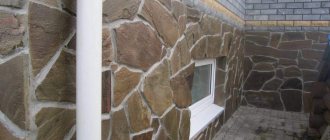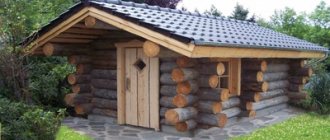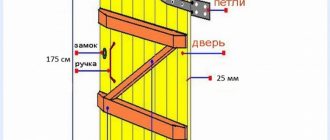Over time, any wood loses its original appearance and darkens. In some cases, the cause of darkening and even blackening is mold bacteria, which multiply very quickly in undried wood. But even completely dry wood becomes dark over time due to exposure to sunlight and moisture. That is why the wood is sanded before applying the coating.
Sanding a log frame allows you to remove the top blackened layers and prepare the wood for further processing.
Why is grinding of a log house needed?
Thanks to correctly performed grinding of the log house, the old darkened layer is removed.
This improves not only the appearance of the house, but also allows you to restore the natural properties of wood and improve its quality. During the grinding of the log house, the following are also eliminated:
- mechanical damage to the log,
- exposed resin,
- resin pockets,
- remnants of bark,
- mold,
- not deep blue.
To properly carry out sanding at home, you need to have small, but extremely important knowledge and understand the differences between sanding methods, since today they can be divided into three main methods.
Recognized advantages and disadvantages of a log house
Wooden design
- environmental friendliness;
- security;
- durability;
- wear resistance;
- resistance to deformation;
- low thermal conductivity;
- frost resistance;
- excellent sound insulation;
- natural ventilation;
- ease of care;
- healing aroma;
- amazing appearance;
- favorable energy.
A wooden structure also has disadvantages - these are:
- change in natural shade;
- biological activity;
- flammability.
The disadvantages are quite serious, however, proper processing of raw materials will not allow them to overshadow your life in such a beautiful structure.
Sanding the frame with nylon brushes.
When sanding a house using nylon brushes, all visible defects are also removed from the frame, but labor costs increase, as more complex defects, such as: resin pockets, shallow blue discoloration, mechanical damage, resin; You will have to first remove it using sanding discs, and then do the finishing sanding with nylon brushes. And the procedure itself for sanding a log house with nylon brushes takes a little longer than with sanding discs. But there is one big difference worth noting! After nylon brushes, the wood grain appears more clearly on the log house.
Before we start finishing the log house with nylon brushes , we treat it with a flap disk, removing all mechanical damage to the logs, as well as natural defects, namely: resin pockets, hardened resin, etc.
After this, various types of nylon brushes from the German company “Osborn” are used. If the log is difficult to machine, then first we use a nylon brush with P46 grit. After hard-to-cut logs have been rough-sanded, we proceed to finishing using P80 or P120 grit brushes.
When is the best time to sand?
There are a lot of possible answers to this question. Traditionally, the frame is sanded after at least the main shrinkage has passed. During this time, the log dries out and it becomes easier to work with. It is extremely difficult to remove even a thin layer from raw wood. If you need to level it, it will take a lot of time, money for disks and effort.
On the other hand, if you have a frame made of dried timber and logs, then you can sand and process it right away. In this case, having placed the frame under the roof, it is sanded, immediately treated with impregnations and left to shrink in this form. This is done infrequently, although no one forbids it. They usually act according to the usual scheme.
The log house is polished after it has settled
Sanding a log frame with sanding discs
When using sanding with sanding discs, a significant layer of wood is removed from the frame, which in turn leads to an even color of the material and removes 99% of all visible defects. But, on the other hand, after sanding small irregularities will appear on the log house, and the wood grain will be less pronounced.
When sanding a log house with sanding discs, the same principle is used as when sanding a house with nylon brushes. If the log is difficult to machine, we take a disc with a larger P60 grain, and after that we proceed to final grinding of the log house with discs with a P80 or P120 grain.
Do-it-yourself wood sanding
There is often a statement that doing grinding yourself and with your own hands is difficult and time-consuming. This statement is not entirely correct and is connected with the purpose of selling services for polishing a house, its walls, and sometimes the floor and ceiling.
In fact, the procedure itself is not complicated; it can be done with your own hands. Another thing is the complexity of the procedure. Outwardly, it may seem that grinding is done quickly. In fact, this takes a lot of time. For example, a person who is constantly grinding manages to make up to 20 square meters of a log house wall in a working day. But the log cannot be properly leveled the first time, at least not by hand cutting. The procedure must be carried out a second time, and inside a third.
In addition, the question arises with the tool.
Sandblasting a log frame.
During the processing of a log house using the abrasive-jet method using sandblasting, deep processing of the wood occurs, which leads to brushing of the surface, that is, to a more obvious manifestation of the pattern. Using this method, it is possible to perform a deeper brushing of the log house, as a result the surface will become more corrugated, with a clearly defined wood pattern.
Sandblasting a log house requires the use of special equipment: a sandblasting machine, a compressor and special consumables consisting of a certain type of sand. The processing of the log house is carried out using a non-contact method, the mixture is supplied under high pressure to the surface being treated. Thanks to contactless processing, there are no traces left on the log house, such as unevenness, scorching, etc.
Sanding a house using the abrasive jet method is non-contact. Using a sandblasting machine and a powerful compressor, a special sand mixture is supplied to the log house under high pressure, which avoids any mechanical damage to the log house and significantly increases the speed and quality of work.
How to sand timber walls
The tools used are the same as for processing logs. A specific choice can only be made by assessing how deeply you need to remove the top layer of wood.
If the bathhouse is made of profiled or laminated timber, most likely you do not need to level anything. Just remove the top darkened layer, if there is one. In this case, if you have a sufficient level of proficiency with an angle grinder, you can work with it. If you don't have enough experience, use an eccentric sander. It will take longer, but the result will be guaranteed to be at least good.
Timber needs to be sanded in different ways. Depending on its geometry
If the walls are made of ordinary timber, then you will have to do a lot of leveling. You can’t do without a grinder here. Moreover, in some places it will be necessary to remove a couple of millimeters of excess - non-ideal geometry and errors in cutting bowls lead to the fact that the difference can be quite significant.
I found a video fragment about a very interesting Pobedit grinding disk, which, it seems, can easily cope with rough grinding and easily remove excess thickness.
Grinding the ends of the log house
At the first stage, we process the ends of the frame with special steel discs of the “Alfadisk Strong No. 2 Extra (3mm)” series. Discs with a grain size of 3 mm allow you to quickly and smoothly remove the most problematic areas on the ends of logs: protrusions, irregularities, curvatures; and give them an even plane without various defects and differences.
Thanks to the larger grain size, the disc penetrates deeply into the ends of the log, which avoids the use of additional tools to give the ends of the logs an even plane along the entire cutting height.
We use “Alfadisc No. 5 Light (0.5 mm)” discs with a grain size of 0.5 mm for chamfering the ends of logs to give the log a more neat and finished look.
After the rough processing of the ends of the frame has been completed, we begin finishing processing. For finishing the ends we use a P80 grit flap disc.
Treatment of log timber with protective compounds
Wood is a soft and fibrous material. Humidity and microorganisms turn it into an unusable material over several years, so after sanding logs and beams, their surfaces must be coated with antiseptic and fire-retardant compounds. The former are responsible for the safety of lumber from the negative effects of mold and fungi, the latter increase fire resistance.
Protective liquids are applied using conventional painting tools: brushes and rollers. If the treatment area is large, then use a spray bottle. First of all, an antiseptic is applied, after it dries and is absorbed into the wood, a fire retardant is applied.
There is another composition that gives the wood certain shades. It is called glaze material. There are more than 40 varieties of glazing compounds on the market today that give wooden walls different shades, including colorless options.
It should be noted that protective liquid materials are divided into two categories: for interior use and exterior use. They cannot be swapped, because the compositions are very toxic for external use, although they have higher protective properties.
Coating the log house with an antiseptic using a spray bottle
What tool are we using?
We do not use classic grinders, as they have a very large number of revolutions. When using nylon brushes, and even sanding pads, this factor can cause burning of the wood during work, which will leave very unsightly marks on the surface of the material being processed.
In our work, we use polishing machines and work at medium speeds, approximately 1900 rpm. This increases the time for surface treatment, but significantly improves the quality of the final result.
When sanding with nylon brushes, we use only proven German brushes from Osborn.
To significantly gain time when treating the house using the abrasive blasting method, we purchased a large-volume sandblasting machine - 75 liters, which allows us to process up to 27 m²/hour.
Step-by-step execution of grinding work
The technology for polishing a log frame is not as scary as it is made out to be. The main thing is to stock up on quality tools, materials and patience. In addition, you should pay attention to some nuances. That is, the work is performed after:
- installing the roof to prevent rain from soaking the walls;
- drying the wood, otherwise the abrasive grinding wheel (wheel) will clog and the wood will become “ruffled” (the nominal drying period is about 12 months from the date of construction of the structure);
- treating the material with a bleaching antiseptic, since the log house darkens during the drying process.
In addition, if the frame is not treated with paint or antiseptic within 7 days after sanding, the surface will darken and the entire work will have to be done again. Here is an article about how to paint a log bathhouse.
It is also not recommended to delay the finishing, otherwise you can forget about a uniform, attractive shade. And yet, the work is done before installing windows, ceiling and floor coverings. I think you understand why: there will be dust - “mother, don’t worry.” So, let's go.
Grinding the timber
Let's start sanding the building:
- We put on goggles, a respirator, and gloves to protect ourselves from dust;
- We do the work from top to bottom;
- we divide the surface into areas so that the work is done more efficiently;
- inspect the walls;
- we remove the pieces that have begun to peel off, otherwise we will damage the instrument;
- we treat the areas with peeled pieces with an adhesive composition and take a technical break so that the substance dries;
- we check the caulk, if there are gaps or cracks, fill them with a special sealant for wood;
- We begin to grind the surface with large nozzles to remove unevenness and roughness;
- we use fine-grained nozzles to remove lint;
- We carry out the work carefully: we do not press too hard on the surface of the walls with the tool, otherwise we will “burn” the wood, we do not make large turns so that furrows and unevenness do not appear;
- We pay special attention to polishing the ends of the log house, because they are most susceptible to the destructive effects of climatic and biological factors;
- We begin to process the ends using nozzles - from No. 35 to No. 120;
- We treat corners and hard-to-reach places with a chisel;
- thoroughly clean the surface from wood dust with a vacuum cleaner;
- we apply protective agents to the walls - antiseptics - help prevent the development of fungus and mold, glazing substances - make the wood more beautiful, fire retardants - increase resistance to fire, acrylates - protect against the harmful effects of climatic factors;
- We paint the frame after sanding (if desired).
We suggest you read: Installing a door frame: tips for beginners
In principle, sanding a log frame with your own hands is a simple but painstaking process, so if you are not confident in your abilities, use the services of masters of construction art.
By the way, watch the video below. Conventional sandblasting is used here. I used this method to make drawings on mirrors 10 years ago. One friend and I used this method to clean the old sides of his GAZ car and clean the rusty metal garage doors. The result is good, you just need a powerful compressor and a large amount of fine, clean quartz sand.
Sanding, done meticulously, will allow your home, bathhouse or any other structure to look flawless, causing incredible delight among guests, indescribable joy among household members and the greenest envy of neighbors!
That's all. I would like to believe that someone found the article useful. Bye! Bye!
Wisdom Quote: It is better to be the subject of envy than compassion (Herodotus).
Wood sander: application, types
A wood sander is an indispensable tool for decorating a country house. Using a sanding machine allows you to speed up the process of sanding non-surfaces - wall cladding, floors, furniture, decorative elements. Wood sanders are convenient, not compact, and allow you to perform high-quality leveling of any kind.
There are several main types of sanders for household use; their different designs and operating principles determine their purpose. For construction, repairs, carpentry and carpentry work, the following types of grinding machines are used:
- machines (LSM) - a tool for aggressive, non-rough processing of wood, plastic, and metal.
- Vibratory grinders (VSM) allow for softer processing through circular movements with small amplitude. The grinding surface of the orbital sander has a rectangular shape, which makes it easier to process corners.
- A type of flat vibratory sander is a delta sander; it is distinguished by a triangular shape of the sole. The delta sander is convenient for processing small, hard-to-reach areas, corners, recesses and recesses.
- An eccentric sander refers to a tool that allows you to grind a surface to a polished state through a combination of rotational, non-oscillating movements of the sanding pad. But an eccentric sander is not suitable for processing small surfaces other than internal corners.
Belt sanders are used where it is necessary to quickly remove a fairly thick layer of material, nettle, for sanding unplaned boards or removing from surfaces. LSMs are also used for precise fitting of parts without processing the cut line.
The material is processed using an abrasive belt, closed in a ring and not tensioned on rotating rollers. When moving, the belt removes a fairly thick layer of material, comparable to the service of an electric planer. The thickness of the removed layer depends on the grain of the abrasive belt.
When choosing a blade blade for yourself, you need to control two parameters: the width, the length of the blade used, and the speed of its rotation. The area of the processed surface depends on the width; the aggressiveness, not the degree of processing, depends on the speed. The standard tape sizes for LSM are: 76x457 mm, 76x533 mm, 76x610 mm.
We suggest you read: Remedy for mold and mildew on the walls in the apartment: which antifungal and antifungal antiseptic is the best against fungal colonies
Useful functions include smooth regulation of the belt rotation speed and an automatic belt centering device that prevents it from slipping off the rollers even during rotational movements.
The operating principle of these tools is similar: grinding is carried out through light circular and oscillatory movements of the grinding surface with an amplitude of up to five mm. The material used is sheets of sandpaper with different grits, secured to the sole using clips or Velcro.
Vibratory sanders provide high quality processing and are used for grinding almost any materials: wood, plastic, metal, plaster and putty, as well as for removing corrosion products and old paint and varnish coatings.
The degree of processing depends on the amplitude of vibrations: for rough processing, an amplitude of 4-5 mm is chosen, for fine grinding - 1.5-3 mm.
The ability to regulate the eccentric amplitude, rotation speed and oscillations are very useful options for a VSM.
An important parameter is the power of the VSM; it is usually in the range of 150-600 W. The higher the power, the greater the productivity and continuous operation time of the tool. Another important factor determining the use of a VSM is the shape and area of the grinding pad. It can be square, rectangular or deltoid.
Orbital sanders are similar in principle to rectangular orbital sanders, but are distinguished by greater productivity and a finer degree of grinding and polishing due to the complex oscillation path.
Surface treatment is carried out with a grinding disc with a diameter of up to one hundred fifty mm; special sanding wheels with different grain sizes or grinding felt attachments are used as an abrasive attachment.
The power of orbital sanders is usually 200-650 W, the speed is up to thirteen thousand per minute, the eccentric oscillation speed is up to twenty-four thousand per minute. Regulating the number of revolutions and oscillations, as well as adjusting the amplitude of the eccentric, like the VSM, are very useful functions.
Also important is the length of the cord - if the cord is short, you will have to constantly use an extension cord. You can also choose a cordless sander.
When purchasing, you should pay attention to the shape of the handle and the weight of the tool, holding it in your hands for some time, trying out the inclusion and regulation of modes.
Video description
Fine chisel work
Almost polishing wood to perfectly smooth walls. This is done by hand using sandpaper and grout. Particular attention is paid to joints and hard-to-reach places. Mandatory before applying paint and varnish coatings.
If the job is done correctly, the result will be a home with a perfectly smooth surface in a fresh light color with a unique wood texture. To preserve it in this form, you need to impregnate the log house with antiseptics and apply a paint coating.
What is sanding?
Grinding as a process does not evoke the most pleasant impressions for many, even when just mentioned. What can I say – this is a monotonous, painstaking, time-consuming, and slightly harmful operation, but it cannot be avoided. Modern requirements for finishing work have increased so much that no one questions that the surfaces must be perfectly smooth.
Fortunately, progress is not lagging behind: such a useful and inexpensive tool as a grinding machine helps to cope with this task. The hated sandpaper for grouting, or the timber clutched in your hands, remains a thing of the past. Equipment manufacturers spoil us with a variety of tools that are designed for many types of repair work, and sometimes it is difficult to choose the tool that is right for you. So how to choose a grinder? It’s not difficult to deal with this issue; the main thing is to understand why this or that tool is needed, and to understand what exactly you want to get as a result.
Rating of the best inexpensive wood sanders for the home in 2021
You can buy the best wood sander for home use from a range of units in the budget category. Inexpensive devices show good power, although they are inferior to professional models in reliability.
Interskol PShM-115/300E
A wood sander with a rectangular base should be chosen for sanding wide surfaces and smoothing outside corners. The vibration amplitude is 2.4 mm, the frequency can be adjusted. A dust container and sanding paper are supplied with the device; a vacuum cleaner can be connected to the unit.
You can buy an Interskol wood sander from 3,400 rubles
Source
How to choose a wood sander
When choosing a wood sander, you need to focus on a number of technical parameters. The performance of the unit, its weight and the dust protection system are important.
Power
The power ratings of wood sanders vary on average from 200-1200 W. Units with low productivity are used for simple repair work. If you are sanding hard wood with high resistance, it is better to take a machine with high power.
Dust removal function
When working with wood, a sander produces a large amount of sawdust. For intensive use, you should choose a model equipped with a garbage disposal or a connection pipe for connecting a powerful vacuum cleaner. In this case, right during use, the grinder will remove sawdust from the working surface.
Sander weight
The weight of a wood sander can vary between 1-3 kg. Heavy models are convenient for processing horizontal surfaces. But for sanding walls or ceilings, it is better to choose a lightweight device weighing no more than 1.5 kg.
What type of wood sander is best?
Belt and surface sanders are best suited for processing flat, wide wood surfaces. They allow you to quickly and efficiently polish frames and veneer panels. If you are going to process round logs, shaped furniture, or grooves and ends using the unit, you should choose an eccentric machine with a disk attachment or a corner model.
Which sander is best for wood at home?
In household use, a sanding machine is needed to solve simple problems - for processing floors, furniture and walls. You can choose one of the low-power models with a performance of 120-600 W.
The network cable of the device must be free to reach a convenient outlet. You need to make sure that your home sander is equipped with a dust removal system, otherwise cleaning up after polishing the wood will be quite difficult.
Grinders with smooth engine start are more reliable
Which sander is better to sand a wooden floor, timber, log house
For processing log houses, timber, floors, and also for lining, a belt-type wood sander is better. Devices from this category demonstrate good performance and speed, cope well with flat surfaces, and not only level, but also polish. If the walls of the house are made of logs, and it is necessary to preserve the relief texture, you should choose an eccentric machine with a disk attachment.










